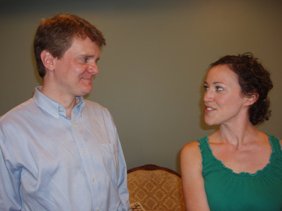The Voysey Inheritance Article
Shaw’s Natural Son Meets Mamet?
by Kelli Marino
 Pictured: Actors Raymond Fox and Rebecca Spence in rehearsal |
While sitting in rehearsal for Remy Bumppo’s Chicago Premiere of The Voysey Inheritance, a spectator can hear the laughter of actors discussing their character’s language. The characters comically pout, explode, and demean, all the while determined to uphold their family name; these characters are real. Director James Bohnen interjects during the read-through: “This language is filled with a fun energy, reminiscent of 1905, but with the verbal energy of a contemporary piece.” The actors find the comedy in their characters’ “desperate” situation which enlivens the text throughout the action.
Harley Granville-Barker’s The Voysey Inheritance (in an adaptation by David Mamet) opens the 08/09 season. Artistic Director Bohnen wants to challenge audiences to find beauty in the language in this Edwardian piece, and the identifiable humanity in the characters as well. “Voysey is emblematic of the plays we do,” says Bohnen, “but this play pushes the boundaries of typical Remy Bumppo theatre because we’ve never done Mamet.”
Set at the turn of the 20th century, Barker’s Voysey explores middle-class hypocrisy and corruption while fighting to preserve a family’s reputation. Edward Voysey learns of his father’s corrupt dealings within the family business and knows there is only one ethical solution. His moral stance conflicts with his siblings’ fierce defense of their incomes, and Edward must take control.
Barker’s divine language and success is credited to his friendship with George Bernard Shaw. For those Remy Bumppo fans who may have seen Shaw’s Mrs. Warren’s Profession in the 2006/07 season, or Major Barbara in the 2003/04 season, Barker’s style and wit will emanate with the provocative power of great theatrical language. Aah, the provocative power of great theatrical language. What is it that makes great theatrical language? The author of course. “[People] hint that he is my natural son,” writes Shaw in his Letters, and even though Shaw was, as he said, “physically incapable of parentage,” historians still speculate on their relationship. Barker became acquainted with Shaw as a young actor, who then became his manager and co-director. As the only manager to proudly direct and produce Shaw’s “outside the conventions of society” plays, it can be assumed that without Barker, many of Shaw’s plays may never have been produced. Barker produced sixteen of Shaw’s world or London premieres between 1904 and 1913, challenging the society that was most important to the theatre.
It may seem that Barker learned from Shaw’s many works, but Shaw remarks that Barker “is always useful when a touch of poetry and refinement is needed.” Shaw’s style is formal and caricatured by melodrama and romantic comedy which projected social critiques within comedic characters. While Barker does write in the Shavian vein, his style is much more identifiable, meaning that his subjects were contemporary, recognizable figures of the Edwardian middle-class who added wit to arguments and kept audiences interested in the character’s actions. “Barker’s language projects a symphonic, even operatic quality,” says Bohnen. Big ideas and complex thoughts that go on and on, sentence after sentence, is what Barker gives as he challenges his audience. His characters speak genuinely to the audience’s humanity.
The language in Barker’s The Voysey Inheritance is truly human, but Mamet’s sublime adaptation can ease theatre goers who might shy away from Shavian and Edwardian drama. Considering David Mamet’s reputation for edgy and often vulgar plays, his adaptation of Voysey disrupts neither style nor action. Mamet keeps the original action and setting remarkably central, but he brings a new musical energy to the play, and considerably shortens the length. At the first read through with the cast, Bohnen elaborates on Mamet’s brilliance:
“By shrinking the play Mamet clarifies the storytelling. He works with Barker and Shaw’s structural style. Most importantly, Mamet feels the music, the insistent rhythm of the play. Mamet’s music is often atonal and spare, forcing words past their breaking point. It is the pauses, the thinking time, the dialogue, and action that create the rhythm. You have to hear the music to do this piece.”
Mamet’s notable rhythm often includes his characters interrupting one another, trailing off at the end of thoughts, and most identifiably, speaking in staccato-esque rhythms. But Voysey, like Bohnen says, blends Mamet’s style with that of Barker’s. The original 1905 production found that the scenes were slow and the actors played the scenes even slower. Mamet alleviates this stylistic problem. “The score of the play is pretty brisk,” Bohnen concludes, “It is passionate and subtle.” And it is hilarious!
